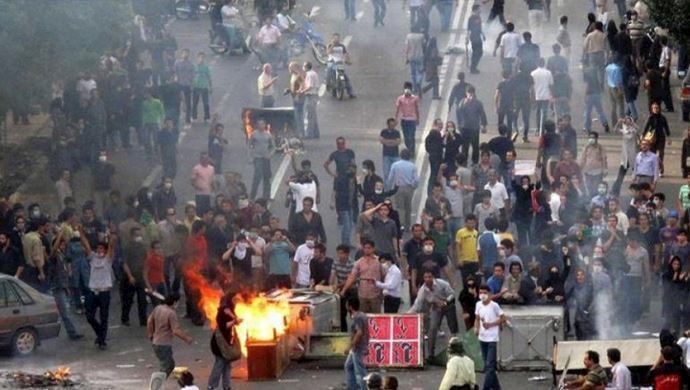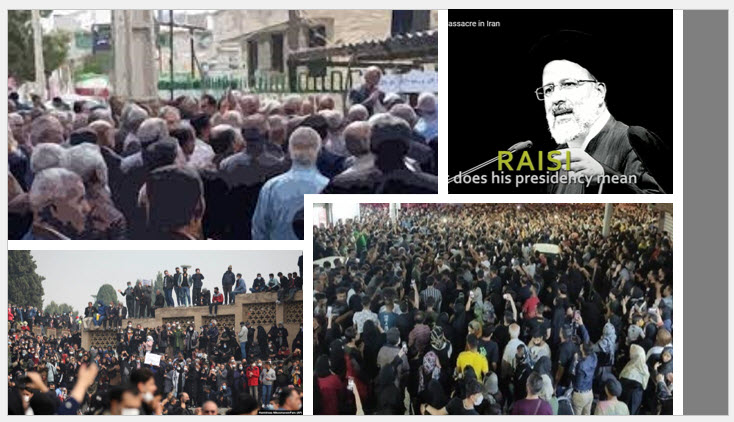
For more than four decades, Iran’s theocratic dictatorship has justified its rule in part with a narrative that says it is the only viable option for the governance of an Iranian nation.
For more than four decades, Iran’s Ministry of Intelligence and state media have sought to demonize the leading pro-democracy Resistance group, the People’s Mojahedin of Iran (PMOI/MEK), claiming the MEK lacks internal support. But when the regime’s Supreme Leader Ali Khamenei chose Ebrahim Raisi as the regime’s president last year, the regime gave plenty of grounds to doubt the sincerity of that assertion.
Previously, Raisi had been one of the key perpetrators in the alleged annihilation of the MEK. He was one of four members of the Tehran “death commission” in 1988, which was responsible for the murder of 30,000 political prisoners, many of whom were MEK supporters.
Raisi continued to make contributions to the long-term repression of dissent in other ways, and in 2019, while serving as head of the judiciary, he presided over significant portions of a crackdown on nationwide protests that resulted in the deaths of an additional 1,500 nonviolent activists.
Although the regime increased its repressive actions to give the impression that it was strong, in reality, its frailty is on display. Since May, when teacher’s union-planned protests turned into demonstrations against arbitrary reductions in food subsidies and a deadly building collapse that activists used as an illustration of the consequences of systemic corruption. Now, domestic protests have been a nearly constant feature of life in Iran.

By now, it ought to be obvious that the regime’s repressive plan to choose Raisi was unsuccessful. In fact, public unrest is still as strong and widespread as it was prior to Raisi’s election.
Undoubtedly, the increased public awareness of organized opposition, particularly that which goes by the name of the MEK, has encouraged such activities. Through the operations of its network of Resistance Units, the MEK has established its presence. Beginning this year, that network was able to take credit for the destruction of a recently unveiled statue of the terrorist Quds Force commander who was killed in action, as well as for seizing control of the state media broadcast signals and using them to repeat calls for regime change and play Massoud and Maryam Rajavi speech excerpts.
Such signs of the regime’s vulnerability and lack of popular support are being observed by the international community. However, more needs to be done to direct Western policymakers toward a correct comprehension of the regime’s true vulnerability and the possibility of revolutionary change.
Of course, many of these decision-makers have been aware of that potential for a long time, as shown by their consistent attendance at international conferences and protests that the National Council of Resistance of Iran (NCRI) hosts to draw attention to the advancements that its main constituent group has made within Iranian society. Some of these supporters contributed messages earlier this month to go along with those provided by 5,000 Resistance Units inside Iran for broadcast at the MEK’s base of operations in exile, Ashraf 3, in Albania.
In one of these messages, Tony Clement, a former Canadian government minister, stated: “There is a rising tide of protests… that encourage the people of Iran to voice their opposition to the regime, and shatters the regime’s air of invincibility and intimidation, which they seek to use to denigrate the morale of people who wish to confront this regime.”
Unfortunately, for the majority of the past 43 years, that strategy has been more or less successful. In fact, the regime’s “air of invincibility” even seems to have persuaded the United States and other strong Western nations that actively opposing an established Iranian leadership for which there was allegedly no viable alternative would have been futile. But over time, more and more decision-makers have begun to acknowledge the NCRI as a suitable substitute.
As long as the international community does not take any action to placate, legitimize, or otherwise strengthen the clerical regime, the necessary overthrow is now more within reach than ever before, and the Iranian people will undoubtedly be able to reach out and claim it.
MEK Iran (follow us on Twitter and Facebook), Maryam Rajavi’s on her site, Twitter & Facebook, NCRI (Twitter & Facebook), and People’s Mojahedin Organization of Iran – MEK IRAN – YouTub

